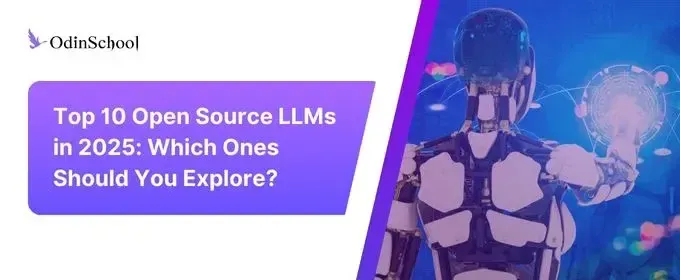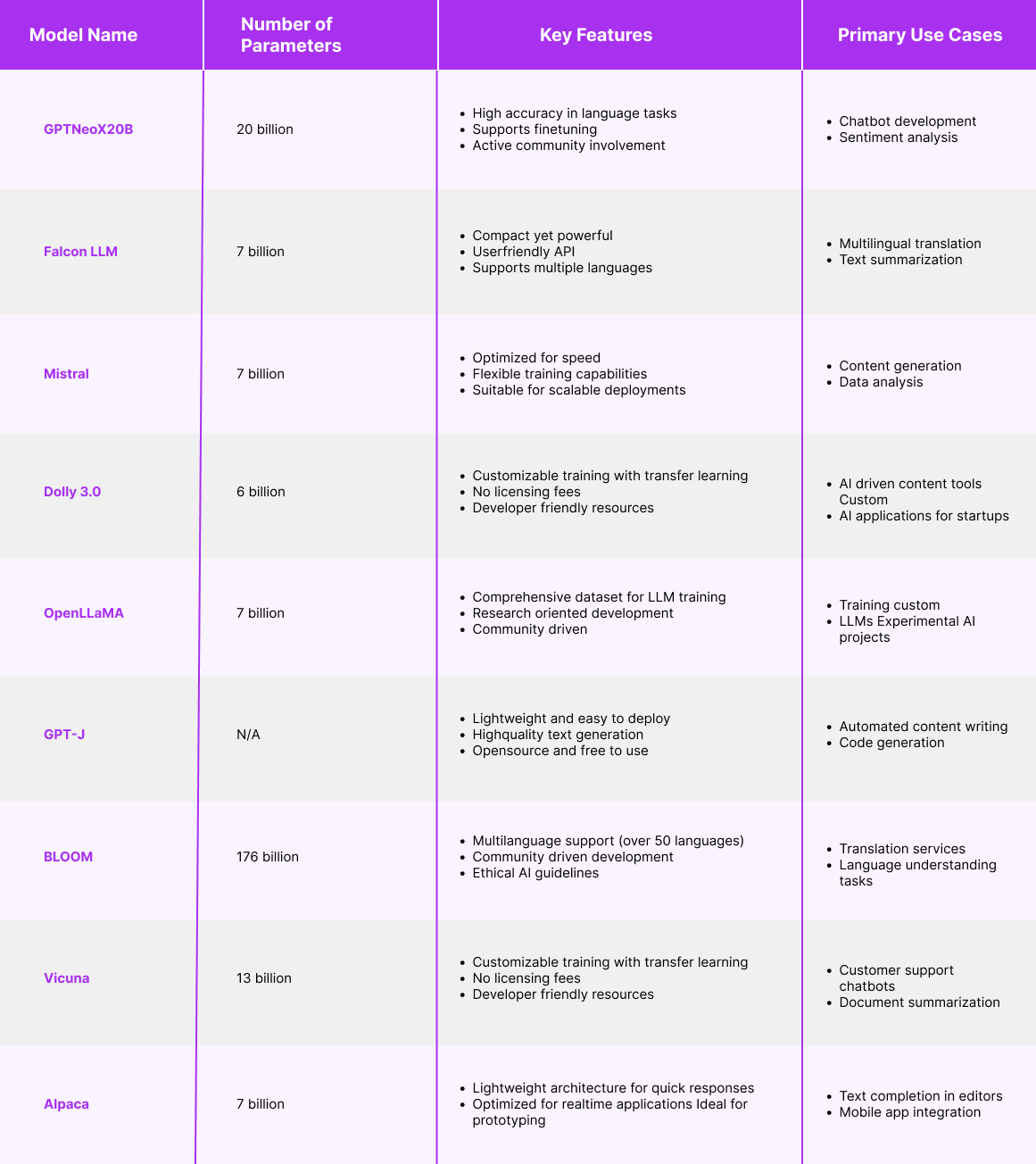Top 10 Source LLMs to Explore in 2025

In today's tech-driven world, the increasing prominence of large language models (LLMs) is hard to ignore.
.webp)
But what exactly is an LLM, and why are they so critical in the world of artificial intelligence today? More importantly, which open-source LLMs should you explore in 2025?
This post aims to answer these questions and provide a deep dive into the top 10 open-source LLMs that stand out.
Before delving into the top LLMs, it's important to understand what an LLM is.
An LLM, or large language model, is a type of artificial intelligence model designed to understand and generate human-like text. These models are trained on vast amounts of text data, enabling them to perform tasks such as text completion, summarization, translation, and even creative writing.
What is the Main Goal of Generative AI?
The main goal of generative AI, which includes LLMs, is to generate content—be it text, images, or even music—that mimics human creativity. Generative AI aims to streamline tasks traditionally handled by humans, from drafting emails to writing code, making it an essential tool in sectors like healthcare, finance, and customer service.
As we progress into 2025, the capabilities of generative AI continue to expand, with open-source LLMs leading the charge in accessibility and customization.
Why Choose Open Source?
Choosing an open-source LLM offers several benefits over proprietary models:
- Cost-Effectiveness: Open-source models are typically free to use, making them ideal for businesses and individuals with budget constraints.
- Flexibility: You can customize these models according to specific requirements, adding new features or modifying existing ones.
- Community Support: Open-source models often come with active communities that contribute to their development, ensuring regular updates and improvements.
With these factors in mind, let's explore the top 10 open-source LLMs in 2025.

1. GPT-NeoX-20B
GPT-NeoX-20B is an impressive large language model developed by EleutherAI. As an open-source alternative to GPT-3, it boasts 20 billion parameters, making it one of the largest LLMs available in the open-source community.
Key Features:
- High Accuracy: Performs well in language understanding tasks such as text summarization and sentiment analysis.
- Customization: Supports fine-tuning for domain-specific applications.
- Active Community: Regularly updated by the EleutherAI community
Use Case Example: GPT-NeoX-20B can be utilized for creating chatbots capable of understanding complex queries and providing accurate responses, making it suitable for customer service applications.
2. Falcon LLM
Developed by the Technology Innovation Institute, Falcon LLM is gaining traction as an open-source large language model with exceptional performance metrics. It's known for its smaller size without compromising on accuracy.
Key Features:
- Compact Yet Powerful: Optimized to deliver fast results while requiring fewer computational resources.
- User-Friendly API: Allows easy integration with existing projects.
- Support for Multiple Languages: A versatile choice for global projects.
Use Case Example: Ideal for multilingual document translation services due to its ability to understand and generate text in various languages.
3. Mistral
Mistral is a cutting-edge open-source LLM that is focused on natural language processing tasks. The model is built to handle a range of applications from content generation to complex data analysis.
Key Features:
- Optimized for Speed: Engineered to deliver results quickly, even with large datasets.
- Flexible Training: Can be fine-tuned on specific datasets for better accuracy.
- Scalable: Suitable for deployment in both small-scale projects and enterprise environments.
Use Case Example: Mistral is often used in content creation tools that require the generation of high-quality, SEO-friendly text for blogs, articles, and marketing materials.
4. Dolly 3.0
Named after the famous cloned sheep, Dolly 3.0 is an open-source LLM built by Databricks. It's designed to democratize access to AI, allowing developers to easily build and deploy their own AI applications.
Key Features:
- Customizable Training: Supports transfer learning, allowing for rapid customization.
- Open-Source and Free: No licensing fees, making it accessible to everyone.
- Developer-Friendly: Comes with comprehensive documentation and community support.
Use Case Example: Ideal for startups and small businesses that need a reliable LLM without incurring high costs, such as creating AI-driven content generation tools.
5. 5. OpenLLaMA
OpenLLaMA is an open-source initiative inspired by Meta's LLaMA models. It aims to provide a highly efficient LLM that is accessible to developers and researchers.
Key Features:
- High Efficiency: Optimized to perform well even on modest hardware configurations.
- Modular Design: Allows easy swapping of different components for customization.
- Support for Multiple Frameworks: Compatible with TensorFlow, PyTorch, and other machine learning frameworks.
Use Case Example: A popular choice for academic research, especially in fields like computational linguistics and AI ethics.
6. RedPajama
RedPajama is a project focused on replicating the dataset used to train Meta's LLaMA models. It provides an alternative for researchers who want to train their own LLMs without relying on proprietary datasets.
Key Features:
- Comprehensive Dataset: Includes a variety of data types to improve model training.
- Research-Oriented: Ideal for academic and experimental AI projects.
- Transparent Development: Open to community contributions, ensuring ongoing improvements.
Use Case Example: Used by researchers to train custom LLMs for specific use cases such as legal document analysis or medical data interpretation.
7. GPT-J
GPT-J, developed by EleutherAI, is a 6-billion-parameter LLM that serves as an accessible alternative to GPT-3. It’s widely recognized for its strong performance in text generation tasks. It is also suitable for more specialized applications like code generation, question answering, and chatbot development. Due to its open-source nature, users can customize and fine-tune GPT-J according to their needs, enabling more control over the model’s output and making it an ideal option for both experimental projects and practical deployments.
Key Features:
- Relatively Lightweight: Easier to deploy than larger models like GPT-3.
- High Text Generation Quality: Generates human-like text for various applications.
- Open-Source License: Free to use and modify.
Use Case Example: GPT-J is commonly used in automated content writing tools to generate articles, social media posts, and marketing copy.
8. BLOOM
BLOOM is a large language model developed by the BigScience initiative, an open collaboration involving hundreds of researchers worldwide. It supports multiple languages, making it one of the most versatile LLMs.
Key Features:
- Multi-Language Support: Capable of generating text in over 50 languages.
- Community-Driven: Built through collaborative efforts, ensuring diverse input.
- Ethical AI Focus: Developed with guidelines to minimize bias.
Use Case Example: BLOOM is well-suited for applications in translation services, where understanding diverse languages is essential.
9. Vicuna
Vicuna is a fine-tuned version of LLaMA, designed to be highly accurate and efficient in performing language understanding tasks. It’s known for its user-friendliness and ease of deployment.
Key Features:
- User-Friendly Interface: Easy to set up and use in various applications.
- High Accuracy: Performs well in language comprehension and summarization tasks.
- Scalable Solutions: Suitable for both small startups and large enterprises.
Use Case Example: Often used in customer support chatbots to provide quick and accurate responses to common queries.
10. Alpaca
Alpaca, fine-tuned from LLaMA, is known for its lightweight architecture and quick response times. It’s particularly popular among developers who want to integrate LLM capabilities into mobile and web applications.
Key Features:
- Lightweight Architecture: Requires fewer computational resources.
- Fast Response Time: Optimized for real-time applications.
- Ideal for Prototyping: Great for developers experimenting with AI functionalities.
Use Case Example: Alpaca can be used to add smart text completion features in text editors or coding platforms.
Final Thoughts
As generative AI continues to gain momentum, understanding how to effectively use and implement large language models (LLMs) is becoming a crucial skill for professionals across various fields.
The ability to harness the power of AI for automating tasks, generating content, and making data-driven decisions can provide a competitive edge in today's job market.
Whether you're a developer, marketer, or data scientist, learning how to work with generative AI equips you with the tools needed to stay ahead of the curve and adapt to the evolving technological landscape.
To help individuals master this rapidly advancing field, the Applied Generative AI Course by OdinSchool, in collaboration with E&ICT Academy, IIT Guwahati, offers a comprehensive learning experience.
With advanced certification from IIT Guwahati, live online classes, a 2-day campus immersion program, and alumni status, the course provides a blend of theoretical knowledge and practical skills that will prepare you to excel in the world of AI. This program is designed to make learning generative AI accessible and impactful, regardless of your prior experience level.
Final Words
As the demand for AI-powered solutions continues to grow, open-source LLMs offer a cost-effective and customizable way to integrate powerful language understanding capabilities into various applications. These top 10 open-source LLMs for 2025 provide a starting point to explore the world of generative AI, allowing businesses, researchers, and developers to leverage cutting-edge technology without breaking the bank.
So, which LLM will you choose for your next project?